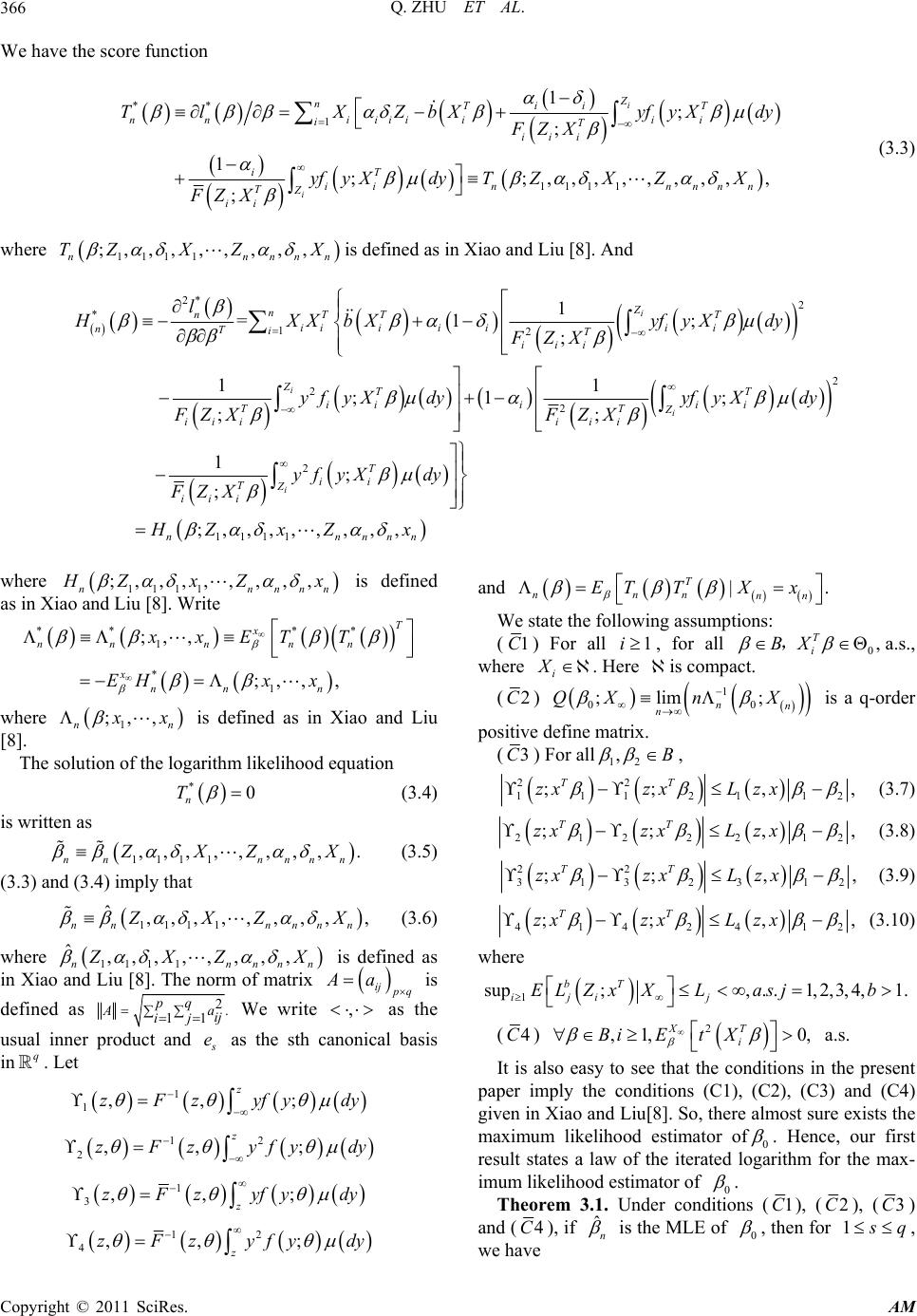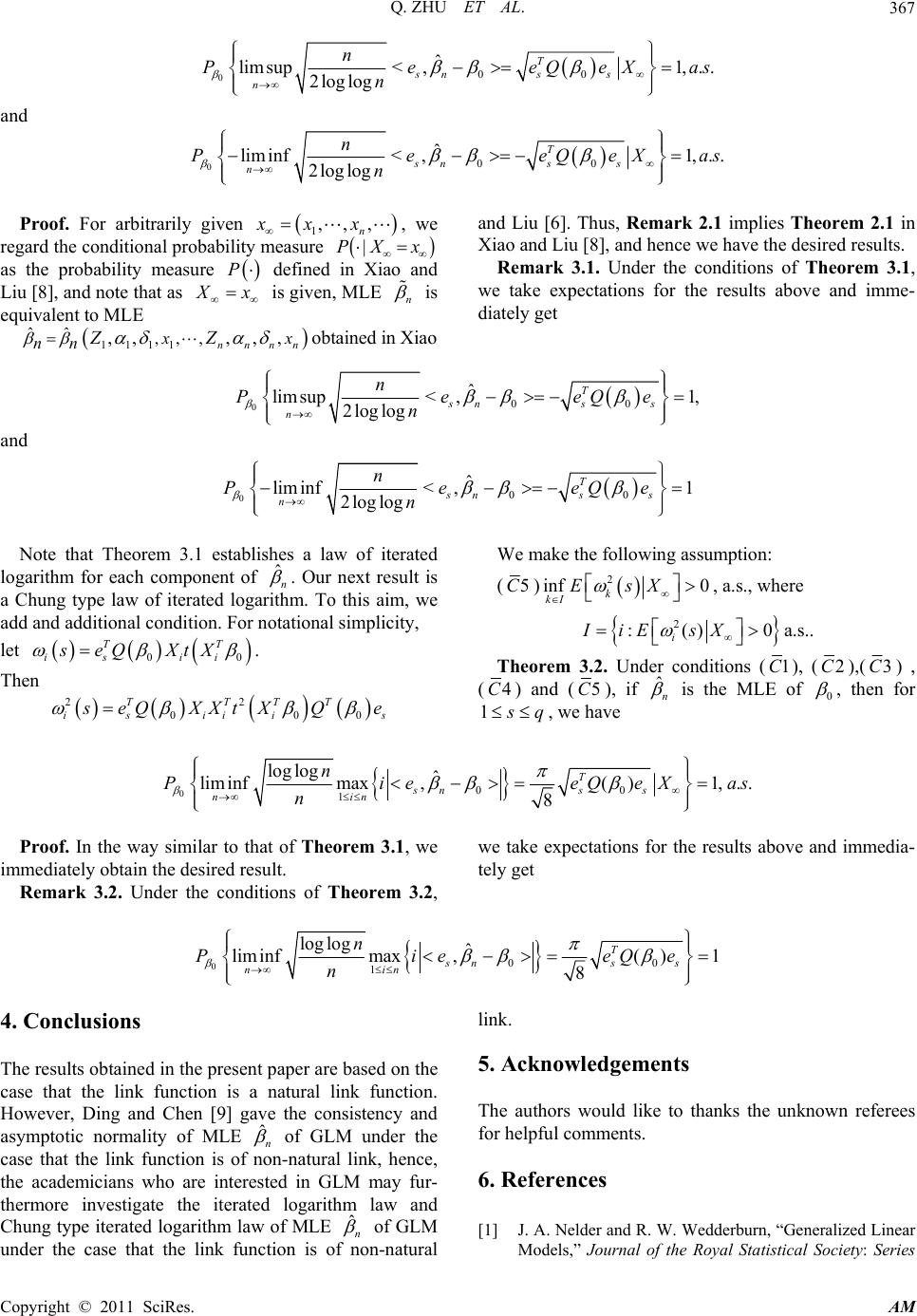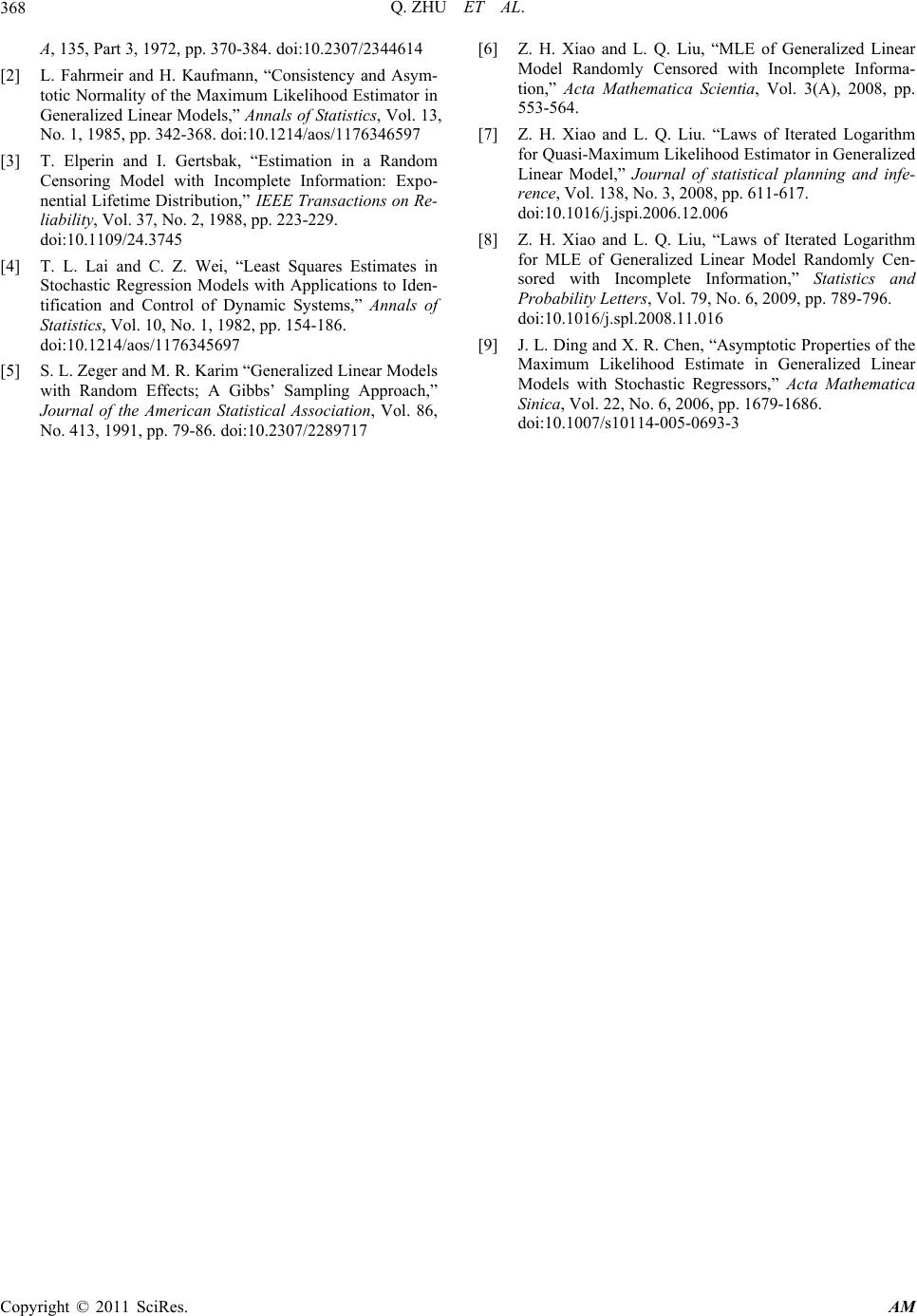Paper Menu >>
Journal Menu >>
 Applied Mathematics, 2011, 2, 363-368 doi:10.4236/am.2011.23043 Published Online March 2011 (http://www.SciRP.org/journal/am) Copyright © 2011 SciRes. AM Iterated Logarithm Laws on GLM Randomly Censored with Random Regressors and Incomplete Information# Qiang Zhu1, Zhihong Xiao1*, Guanglian Qin1, Fang Ying2 1Statistics Research Institute, Huazhong Agricultural University, Wuhan, China 2School of Science, Hubei University of Technology, Wuhan, China E-mail: xzhhsfxym@mail.hzau.edu.cn Received December 8, 2010; revised January 26, 2011; accepted Janu ary 29, 2011 Abstract In this paper, we define the generalized linear models (GLM) based on the observed data with incomplete information and random censorship under the case that the regressors are stochastic. Under the given condi- tions, we obtain a law of iterated logarithm and a Chung type law of iterated logarithm for the maximum li- kelihood estimator (MLE) ˆn in the present model. Keywords: Generalized Linear Model, Incomplete Information, Stochastic Regressor, Iterated Logarithm Laws 1. Introduction The generalized linear model(GLM) was put forward by Nelder and Wedderburn [1] in 1970s and has been stu- died widely since then. The maximum likelihood esti- mator (MLE) ˆn of the parameter vector in GLM was given and its strong consistency and asymptotic normality were discussed by Fahrmeir and Kaufmann [2] in 1985.The randomly censored model with the incom- plete information was presented by Elperin and Gertsba- kin [3] in 1988.The analysis of the randomly censored data with incomplete information has become a new branch of the Mathematical Statistics. Xiao and Liu [4] in 2008 discussed the strong consistency and the asymp- totic normality of MLE ˆn of GLM based on the data with random censorship and incomplete information. Xiao and Liu [5] discussed laws of iterated logarithm for quasi-maximum likelihood estimator of GLM in 2008, meanwhile, Xiao and Liu [6] in 2009 discussed laws of iterated logarithm for maximum likelihood estimator of generalized linear model randomly censored with in- complete information under the regressors given. How- ever, Lai and Wei [8], Zeger and Karim [9] have studied the linear regression model under the case that the re- gressors are stochastic. In the practical application, espe- cially in the biomedical social sciences, the regressors in GLM are often stochastic, Fahrmeir [10] investigated GLM with the regressors 1,,n X Xwhich are indepen- dent and identically distributed and gave MLE of matrix parameter without proof under the given conditions. Ding and Chen [11] in 2006 gave asymptotic properties of MLE in GLM with stochastic regressors. So, in the present paper, we will investigate the law of iterated lo- garithm and the Chung type law of iterated logarithm for maximum likelihood estimator of generalized linear mo- del randomly censored with incomplete information un- der the case that regressive variables,1 i X iare inde- pendent but not n ecessarily identically distributed. From a statistical perspective, the importance of those laws stem from the fact that the first one gives in an asy- mptotic sense the smallest 100% confidence interval for the parameter, while the second one gives an almost sure lower bound on the accuracy that the estimator can achi- eve. 2. Model with the Random Regressor Suppose that the respondence variables ,1,2,, i Yi n are one dimension random variables, and regressor vari- able ,1,2,, i X in are q-dimension r andom variables which have the distribution functions ,1,2,, i Kires- pectively. Here, i x is the observation value ofi X , i X i . Write 1ii . Suppose that the observations ,,1,2,, ii YX iare mutually independent and satisfy. *Correspondin g Au tho r. #Foundation items: supported by Huazhong Agricultural University Doctoral Fund (52204-02067) and Interdisciplinary Fund (2008 xkjc008 and Torch Plan F und (2009XH003).  Q. ZHU ET AL. Copyright © 2011 SciRes. AM 364 1) The regression equation: |,1 T ii ii EY Xxmxi (2.1) where the unknown parameter . q B 2) The conditional distribution of i Y under ii X x is the exponent distribution, i.e. exp, 1 iiiii P YdyX xCyybdyi (2.2) where is a -finite measure, parameter i , 1, 2,,in, :0 expCyy dy is the natural parameter space and 0 is the interior of . Since this conditional density integrates to 1, we see that exp ii bC ydy , from which the standard expressions for the conditional mean | ii ii EY Xxb , and the variance, | ii i Var YXx i b , where ,b b denote the first and second derivatives of b, respectively. Suppose that the censor random variables , i U i 1, 2,, n are mutually independent but not necessarily identically distributed, with the distribution function i Gu and ii dG ugudu . Denote i K dx , i x dx 1, 2,,in. Suppose that i U is indepen- dent of , ii YX For 1, 2,,in, let ii iYU I , 0,if ,but the real va isn't observed ,lue of 1,else, i iii UYY ,if 1,1 ,otherwise ii i ii Y ZU Obviously, ,,,,1,2, iii i ZXi is a mutually independent and observable sample. The conditional density and distribution function of i Y underii X x are respectively denoted as ;exp TTT iii fyxCyx ybx ;exp | z TTT iii iii F zxC yxybxdy PYzXx Let 1, ii Gz Gz ;1; TT ii Fzx Fzx , 1, 2,,in. Suppose ,1| ,, if ,, ii i i i P YyUuXxp yu x (2.3) 0|,,1 , if ,, ii ii i YyU uXx yu x P p (2.4) where 01p . This assumption came from T. Elperin and I. Gertsbak, [3]. In the reliab ility study, the instant of an item's failure is observed if it occurs before a ran- domly chosen inspection time and the failure is signaled. Otherwise, the experiment is terminated at the instant of inspection during which the true state of the item is dis- covered. T. Elperin and I. Gertsbak, assumed that the fai- lure time of every item was signaled randomly with p ro- bability p before the rando mly chosen inspectio n time. Then, we have , ,,, iii ii i PY yU uXx P YyXxPUu yux Without loss of generality, assuming that i X is dis- crete, we have iiiii i PYy,UuXxPYyXxPUu (2.5) We first give the following propositions. Proposition 2.1. Under the regular assumptions above, we have ,1,1| , iii i z ii PZ zXx pGyfy dy (2.6) ,1,0| 1;, iii i zT iii PZ zXx pFyxdGy (2.7) ,0| ;. ii i zT iii PZ zXx F yxdG y (2.8) Proof. We only show (2.6) for the discrete case, the continuous case can be shown in the way similar to that of the discrete case. ,1,1 ,, 1 1,, , ii iiiiiiii iiii z ii i iiiiii y zz ii ii PZzX x EIIEIYUX xX x YzYU PYyUuXxP YdyUduXx pGydFypGyfydy (2.9)  Q. ZHU ET AL. Copyright © 2011 SciRes. AM 365 where (2.9) follows from (2.3) and (2.5). Similarly, we can demonstrate (2.7) and (2.8). Suppose that i zis the observation of i Z ,i is the observation of i , i is the observation of i , (2.6), (2.7) and (2.8) imply that for all 1i, the conditional distribution of ,, iii Z under ii X xis the follow- ing (1 ) 1 ( )(;)][(1)(;)() ; ii ii i TT ii iiii ii T iii ii pGzfzxpFzx gz Fzxgzdz (2.10) Let 1,, , n n Z ZZ 1,, , n n zzz 1,, , n n 1,, , n n 1,, , n n 1,, , n n 12 ,,,XXX 1,, , n n X XX 1,, , n n x xx 12 ,, .xxx We easily get the following proposition. Proposition 2.2. For all 1n, we have ,, ,, ,, 1 nnn nnn nnn nnnnn iii iiiii PZ zX x PZ zXx nPZ zXx i (2.11) and ,, ,, (, ,),1, iii iii iii iii nn iii iii ii PZ zXx PZ zXx PZ zXxi (2.12) where () ()nn Z z means ii Z z for 1in . Remark 2.1. Proposition 2.2 implies that under |,,1 i PX xUi are mutually independent and so are ,1 i Yi, and ,,, 1. iii Zi (2.10) and (2.11) imply that the conditional distribu- tion of 111 ,, ,,,, nnn ZZ under nn X x is 1 1 1 ;,1;1; iii i nTT T i iiiiii iiiii ii Fxgd n i pGzfzxp Fzxgzzzz (2.13) The conditional probability measure corresponding to (2.13) is written as |.PXx Meanwhile, let x E and x Var denote the conditional expecta- tion and conditional variance under the conditional pro- bability measure |,PXx respectively. Set 0 do- note the real value of . For notational simplicity, let xx EE and xx Var Var . (2.13) im- plies that the joint distribution of is 111 1 ,,,,, ,,, nnnn ZXZ X 11 1;1; ; iii i i nTT T i iiiiii iiii iiiii ipGzfzxpFzxgzF zxgzdzxdx (2.14) The probability measure (unconditional) correspond- ing to (2.14) is denoted as P . Meanwhile, let E and Var denote the expectation and vari- ance under the probability measure P , respectively. For notational simplicity, let ,PPEE and Var Var It is that the parameters in (2.14) are studied by us. 3. Main Results Furthermore, from (2.14) we get the likelihood function of 111 1 ,,,,, ,,, nnnn ZXZ X as follows 1111 ,,,, ,,,,, nnnn LZX ZX 1 ; 1 1 1; ;,1 i ii T ii ii Tii ii ii T iiiii i npGZf ZX i pFZ XgZ FZXgZXn (3.1) Taking the logarithm to (3.1) and dropping the terms which are free of yield the logarithm likelihood fun- ction: * 1 1111 log ;1 log;1 log; ;,,, ,,,,,, nT niiiiii i TT iii ii nnnnn lfZX FZX FZX lZ XZX (3.2) where 1111 ;,,,,,,,, nnnnn lZ xZx is the loga- rithm likelihood function defined in Xiao and Liu [8].  Q. ZHU ET AL. Copyright © 2011 SciRes. AM 366 We have the score function ** 1 1111 1; ; 1;;,,,,,,,,, ; i i Z nii TT nn iiiiiii iT iii iT ii nnnnn TZ ii Tl XZbXyfyXdy FZX yfyXdyTZXZX FZX (3.3) where 1111 ;,,, ,,,,, nnnnn TZ XZX is defined as in Xiao an d Liu [8]. And 2* 2 * 12 2 2 2 2 111 1 =1 ; ; 11 ;1 ; ;; 1; ; ;,, i i i i Z n nTT T iiiiii i nTiT iii ZTT ii iii TT Z iiii ii T ii TZ iii n l HXXbX yfyXdy FZX yf yXdyyf yXdy FZXF ZX yf yXdy FZX HZ 1 ,,, , ,, nnnn xZ x where 1111 ;,,,,,,,, nnnnn H ZxZ x is defined as in Xiao and Liu [8]. Write ** ** 1 ;,, T x nnn nn xxET T *1 ;,, , xnn n EHx x where 1 ;,, nn x x is defined as in Xiao and Liu [8]. The solution of the log arithm lik elihood equation *0 n T (3.4) is written as 1111 ,,, ,,,,,. nn nnnn Z XZ X (3.5) (3.3) and (3.4) imply that 111 1 ˆ,,,,,,,,, nn nnnn ZXZ X (3.6) where 1111 ˆ,,, ,,,,, nnnnn Z XZ X is defined as in Xiao and Liu [8]. The norm of matrix ij p q Aa is defined as 2. 11 pq A aij ij We write , as the usual inner product and s e as the sth canonical basis in q . Let 1 1,,; z zFzyfydy 12 2,, ; z zFzyfydy 1 3,,; z zFz yfy dy 12 4,, ; z zFz yfy dy and |. T nnn nn ET TXx We state the following assump tions: (1C) For all 1i, for all B ,0, T i X a.s., where i X . Here is compact. (2C) 1 00 ;lim; nn n QXnX is a q-order positive define matrix. (3C) For all12 ,B , 22 1112112 ;; ,, TT zxzxL zx (3.7) 21222 12 ;; ,, TT zxzxLzx (3.8) 22 31323 12 ;; ,, TT zxzxL zx (3.9) 41424 12 ;; ,, TT zxzxLzx (3.10) where 1 sup;,. .1,2,3,4,1. bT iji j EL ZxXLasjb (4C) 2 ,1, 0, XT i BiEt X a.s. It is also easy to see that the conditions in the present paper imply the conditions (C1), (C2), (C3) and (C4) given in Xiao and Liu[8]. So, there almost sure exists the maximum likelihood estimator of0 . Hence, our first result states a law of the iterated logarithm for the max- imum likelihood estimator of 0 . Theorem 3.1. Under conditions (1C), (2C), (3C) and (4C), if ˆn is the MLE of 0 , then for 1 s q , we have  Q. ZHU ET AL. Copyright © 2011 SciRes. AM 367 000 ˆ limsup,1,. . 2log log T snss n n P<eeQeXas n and 000 ˆ liminf,1,.. 2loglog T sns s n n P<eeQeXas n Proof. For arbitrarily given 1,,, n xxx , we regard the conditional probability measure |PX x as the probability measure P defined in Xiao and Liu [8], and note that as X x is given, MLE n is equivalent to MLE 1111 ˆˆ ,,, ,, ,,, nnnn x x nn ZZ obtained in Xi ao and Liu [6]. Thus, Remark 2.1 implies Theorem 2.1 in Xiao and Liu [8], and hence we have the desired results. Remark 3.1. Under the conditions of Theorem 3.1, we take expectations for the results above and imme- diately get 000 ˆ limsup ,1, 2log log T sns s n n P<eeQe n and 000 ˆ liminf ,1 2log log T sns s n n P<eeQe n Note that Theorem 3.1 establishes a law of iterated logarithm for each component of ˆn . Our next result is a Chung type law of iterated logarithm. To this aim, we add and additiona l condition. For notational simplicity, let 00 TT is ii seQXtX . Then 22 000 TTTT is iiis s eQXXt XQe We make the following assumption: (5C) 2 inf 0 k kIEsX , a.s., where 2 :() 0 i IiE sX a.s.. Theorem 3.2. Under conditions (1C), (2C),( 3C) , (4C) and (5C), if ˆn is the MLE of 0 , then for 1 s q , we have 000 1 loglog liminfmax, ˆ() 1,.. 8 T sns s nin n PieeQeXas n Proof. In the way similar to that of Theorem 3.1, we immediately obtain the desired result. Remark 3.2. Under the conditions of Theorem 3.2, we take expectations for the results above and immedia- tely get 000 1 loglog liminfmax,( )1 8 ˆT sss nin n n PieeQe n 4. Conclusions The results obtained in the present paper are based on the case that the link function is a natural link function. However, Ding and Chen [9] gave the consistency and asymptotic normality of MLE ˆn of GLM under the case that the link function is of non-natural link, hence, the academicians who are interested in GLM may fur- thermore investigate the iterated logarithm law and Chung type iterated logarithm law of MLE ˆn of GLM under the case that the link function is of non-natural link. 5. Acknowledgements The authors would like to thanks the unknown referees for helpful co mments. 6. References [1] J. A. Nelder and R. W. Wedderburn, “Generalized Linear Models,” Journal of the Royal Statistical Society: Series  Q. ZHU ET AL. Copyright © 2011 SciRes. AM 368 A, 135, Part 3, 1972, pp. 370-384. doi:10.2307/2344614 [2] L. Fahrmeir and H. Kaufmann, “Consistency and Asym- totic Normality of the Maximum Likelihood Estimator in Generalized Linear Models,” Annals of Statistics, Vol. 13, No. 1, 1985, pp. 342-368. doi:10.1214/aos/1176346597 [3] T. Elperin and I. Gertsbak, “Estimation in a Random Censoring Model with Incomplete Information: Expo- nential Lifetime Distribution,” IEEE Transactions on Re- liability, Vol. 37, No. 2, 1988, pp. 223-229. doi:10.1109/24.3745 [4] T. L. Lai and C. Z. Wei, “Least Squares Estimates in Stochastic Regression Models with Applications to Iden- tification and Control of Dynamic Systems,” Annals of Statistics, Vol. 10, No. 1, 1982, pp. 154-186. doi:10.1214/aos/1176345697 [5] S. L. Zeger and M. R. Karim “Generalized Linear Models with Random Effects; A Gibbs’ Sampling Approach,” Journal of the American Statistical Association, Vol. 86, No. 413, 1991, pp. 79-86. doi:10.2307/2289717 [6] Z. H. Xiao and L. Q. Liu, “MLE of Generalized Linear Model Randomly Censored with Incomplete Informa- tion,” Acta Mathematica Scientia, Vol. 3(A), 2008, pp. 553-564. [7] Z. H. Xiao and L. Q. Liu. “Laws of Iterated Logarithm for Quasi-Maximum Likelihood Estimator in Generalized Linear Model,” Journal of statistical planning and infe- rence, Vol. 138, No. 3, 2008, pp. 611-617. doi:10.1016/j.jspi.2006.12.006 [8] Z. H. Xiao and L. Q. Liu, “Laws of Iterated Logarithm for MLE of Generalized Linear Model Randomly Cen- sored with Incomplete Information,” Statistics and Probability Letters, Vol. 79, No. 6, 2009, pp. 789-796. doi:10.1016/j.spl.2008.11.016 [9] J. L. Ding and X. R. Chen, “Asymptotic Properties of the Maximum Likelihood Estimate in Generalized Linear Models with Stochastic Regressors,” Acta Mathematica Sinica, Vol. 22, No. 6, 2006, pp. 1679-1686. doi:10.1007/s10114-005-0693-3 |

